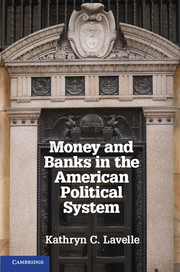Book contents
- Frontmatter
- Contents
- Figures and Tables
- Preface
- Acknowledgments
- Abbreviations
- 1 The Institutional Foundations of Financial Politics in the United States
- Section 1 A Historical Background
- 2 Developing State Capacity for the Conduct of American Finance
- 3 Creating Increasingly Complex Financial Products
- Section 2 Bureaucratic Politics and Finance
- Section 3 The Operation of the Financial Political Economy
- Section 4 Conclusions
- Glossary
- References
- Index
- References
2 - Developing State Capacity for the Conduct of American Finance
Published online by Cambridge University Press: 05 January 2013
- Frontmatter
- Contents
- Figures and Tables
- Preface
- Acknowledgments
- Abbreviations
- 1 The Institutional Foundations of Financial Politics in the United States
- Section 1 A Historical Background
- 2 Developing State Capacity for the Conduct of American Finance
- 3 Creating Increasingly Complex Financial Products
- Section 2 Bureaucratic Politics and Finance
- Section 3 The Operation of the Financial Political Economy
- Section 4 Conclusions
- Glossary
- References
- Index
- References
Summary
Broad tensions have existed throughout American history over the division of power between the federal government and states, most prominently in the areas of taxation and slavery. In the financial area, tensions have been shaped by an American political culture that distrusts government, banks, and bankers. This chapter reviews these distinctive aspects of American government and political culture by specifically questioning the demands that Americans have made on their government with respect to the provision of finance, as well as how governing institutions have responded to these demands. It shows that American financial practices have evolved within a framework of institutions that developed as a result of unique interests and political ideologies at specific historical junctures, layered over time. Thus the answers to these questions provide insight into the origins of the web of regulatory agencies that have emerged in this area, into the difficulties inherent in changing the system to prevent future crises, and the tendency to create new agencies when new problems and ideologies emerge. The answers also provide insight into the role played by political parties in shaping the institutions of finance. The first parties formed around the debates concerning the First Bank of the United States, took shape after the War of 1812 with the Second Bank of the United States, and aligned over divisions in the silver debates at the close of the nineteenth century.
As American political institutions and economic development occurred, the United States built what political scientists term state capacity in the financial area. Strictly speaking, state capacity refers to the building of a central apparatus for the U.S. federal government between 1877 and 1920, when national administrative institutions were built and wrested control away from party domination, direct court supervision, and local orientations. In Stephen Skowronek's analysis of the process, American state capacity grew out of institutional struggles rooted in the way the old regime was structured and was mediated by shifts in electoral politics. Therefore, to understand government action as resulting from Allison's models of either semi-independent organizations operating according to their own logic, or as the outcome of bargaining among units, it is necessary to revisit the older struggles between state and national government, ideologies about the proper division between public and private authority, and the role of the individual citizen in American democracy to see where the component parts came from in the first place.
- Type
- Chapter
- Information
- Money and Banks in the American Political System , pp. 33 - 55Publisher: Cambridge University PressPrint publication year: 2013



